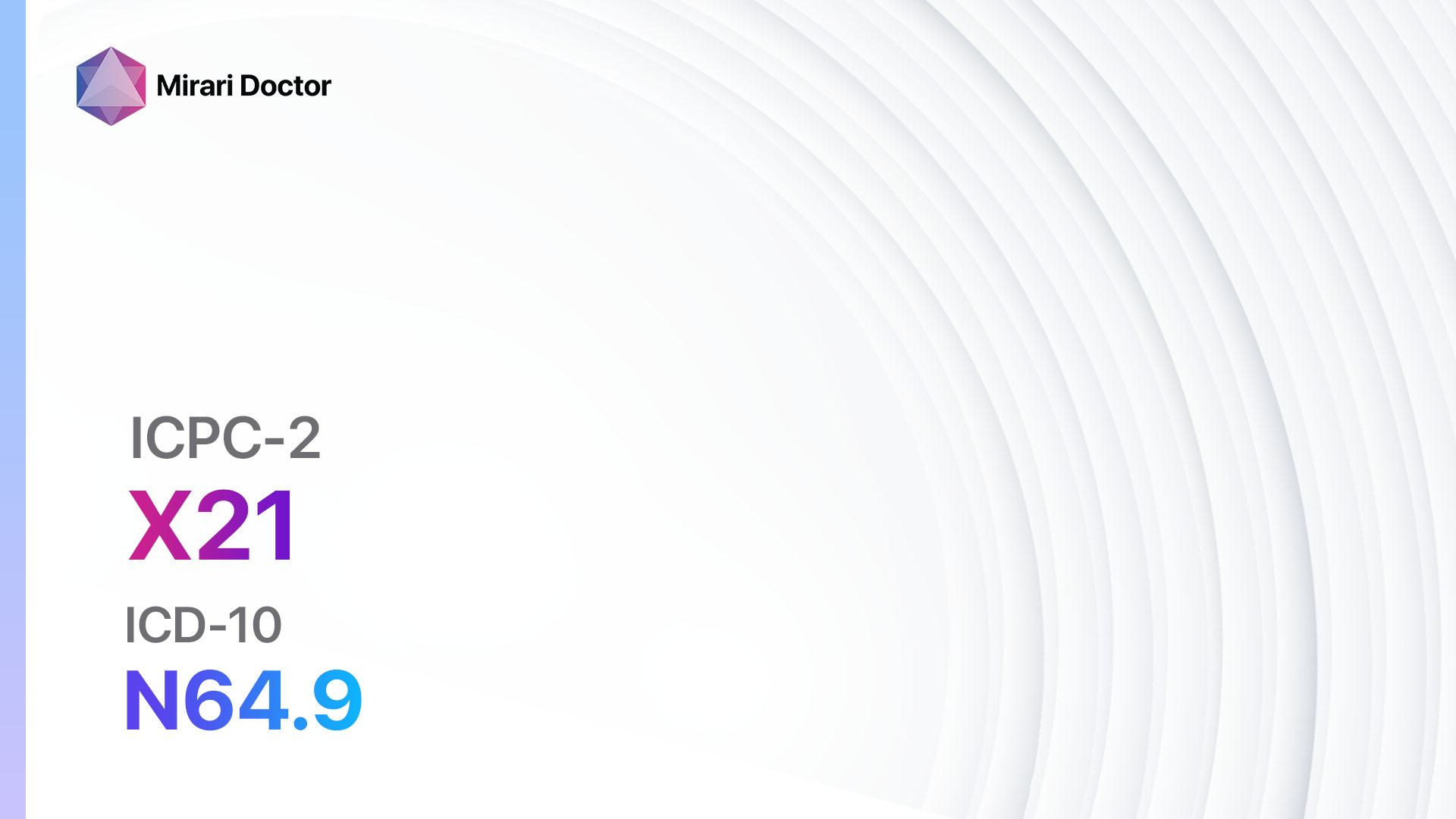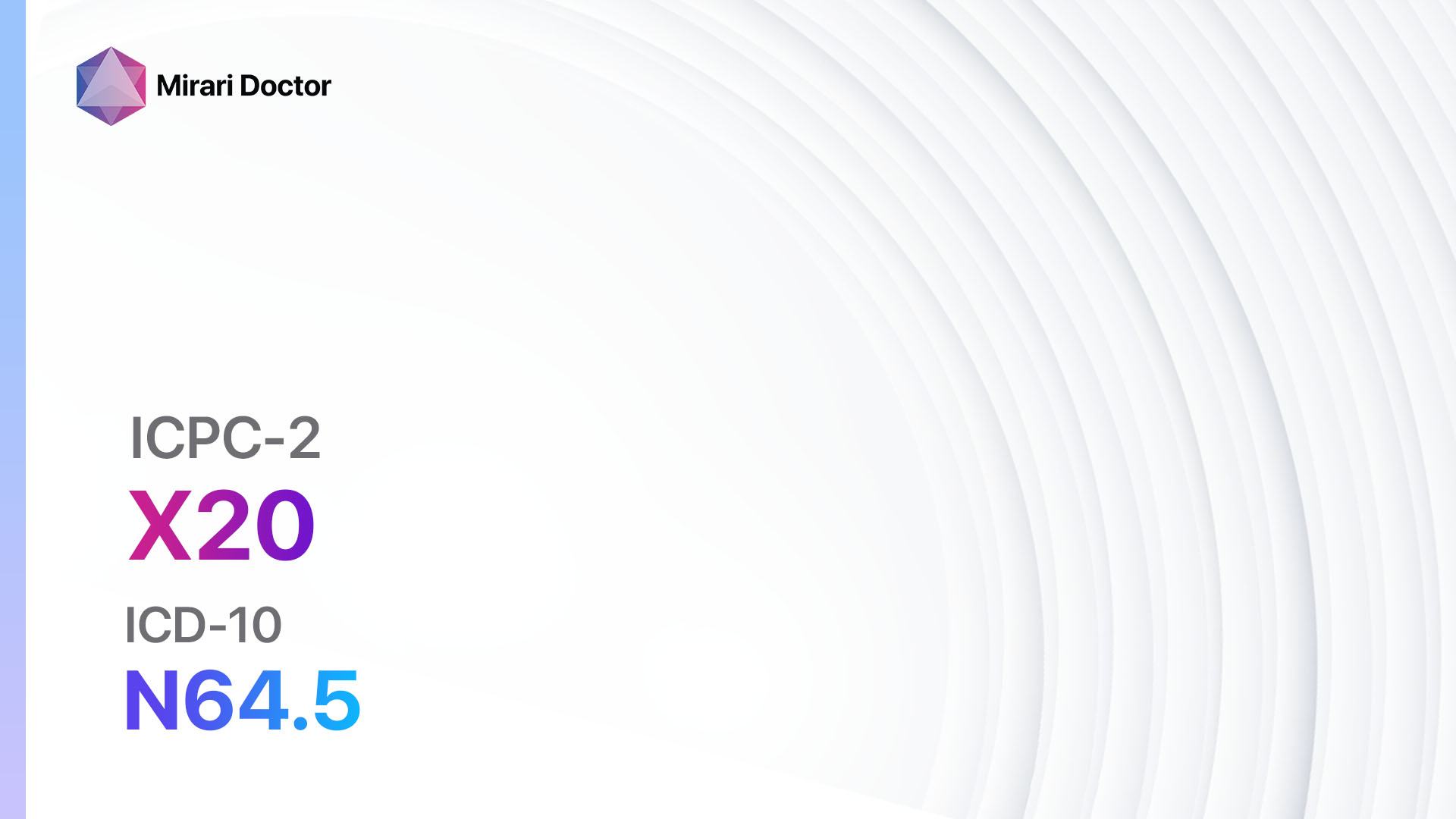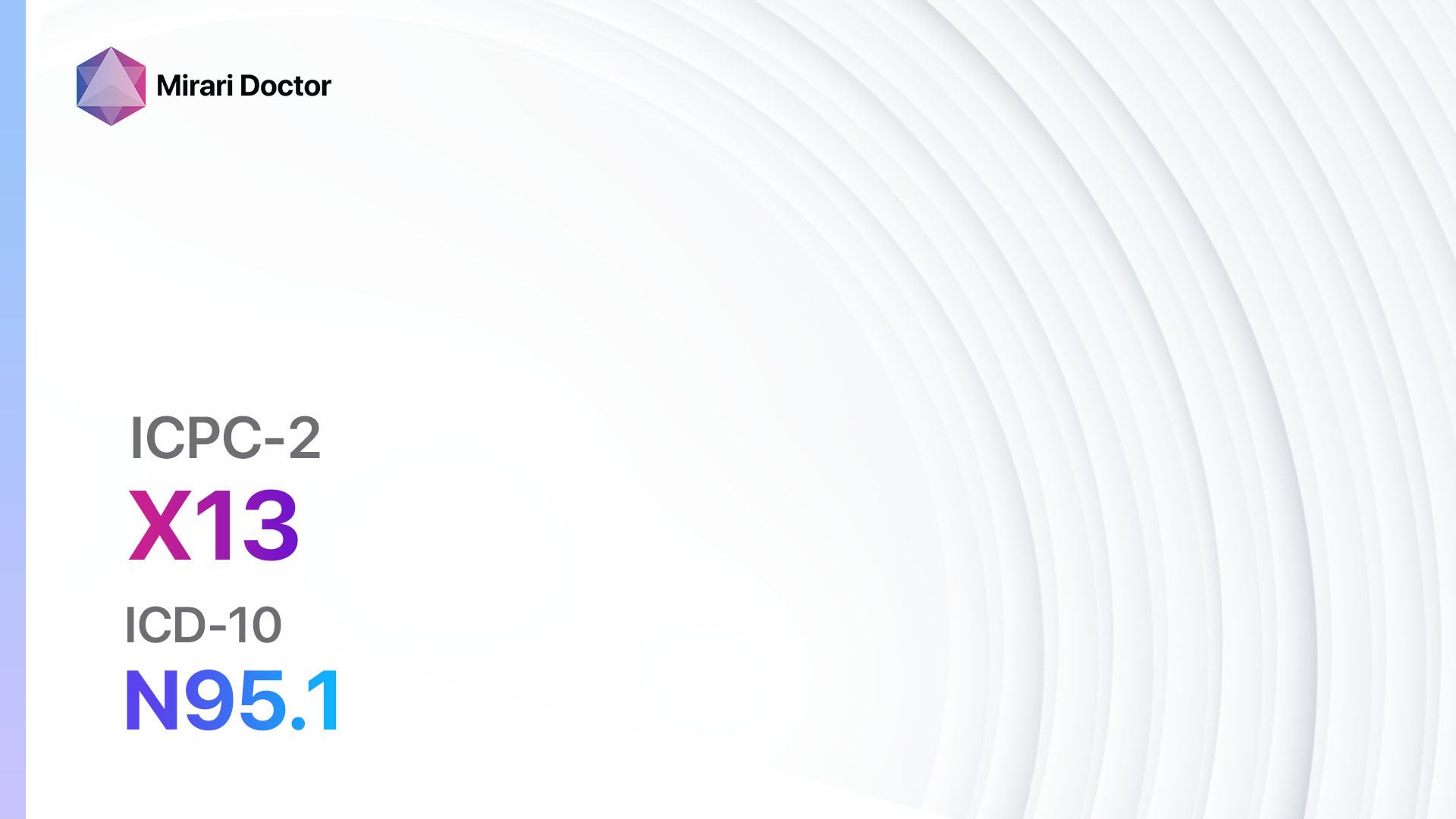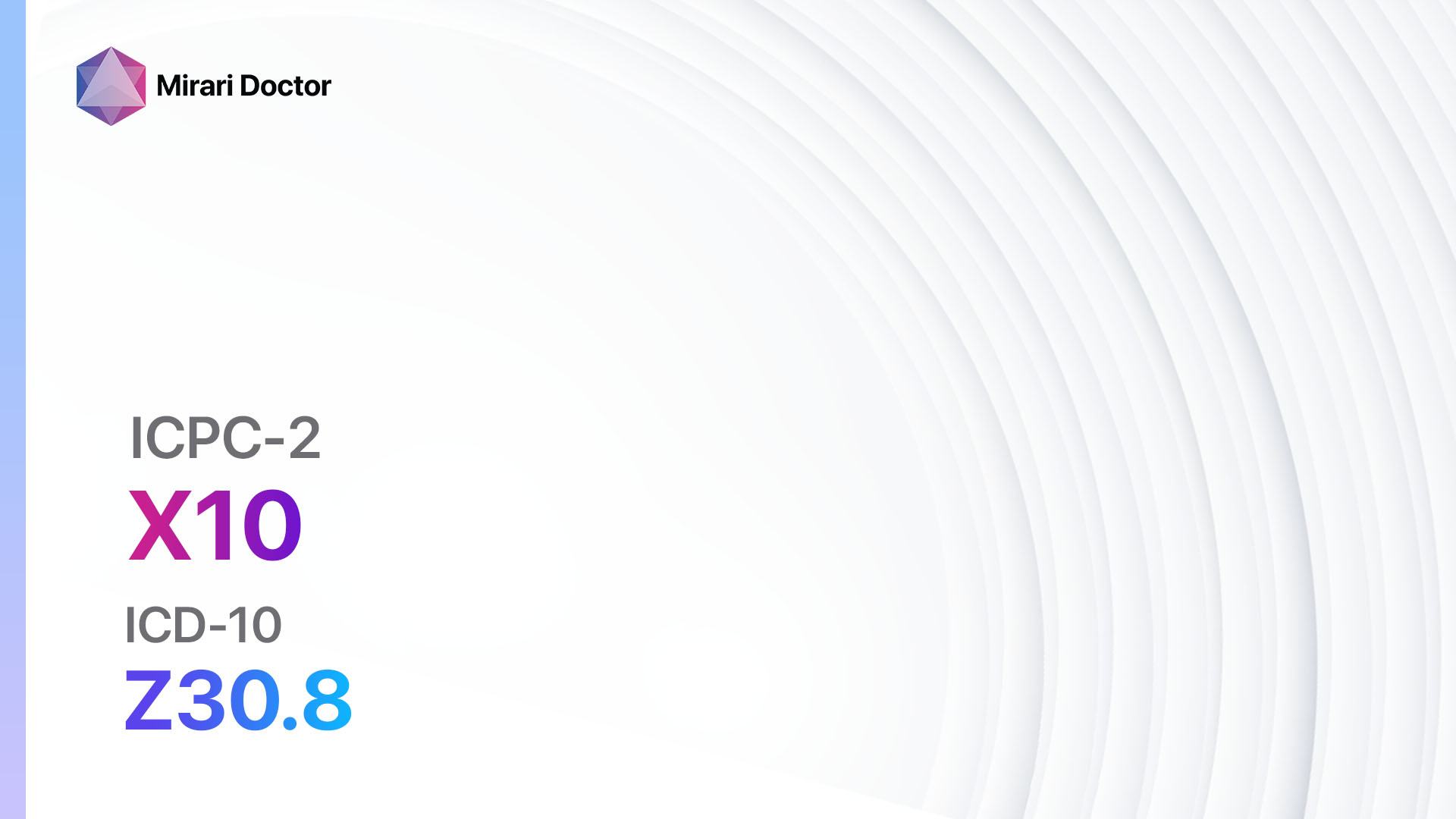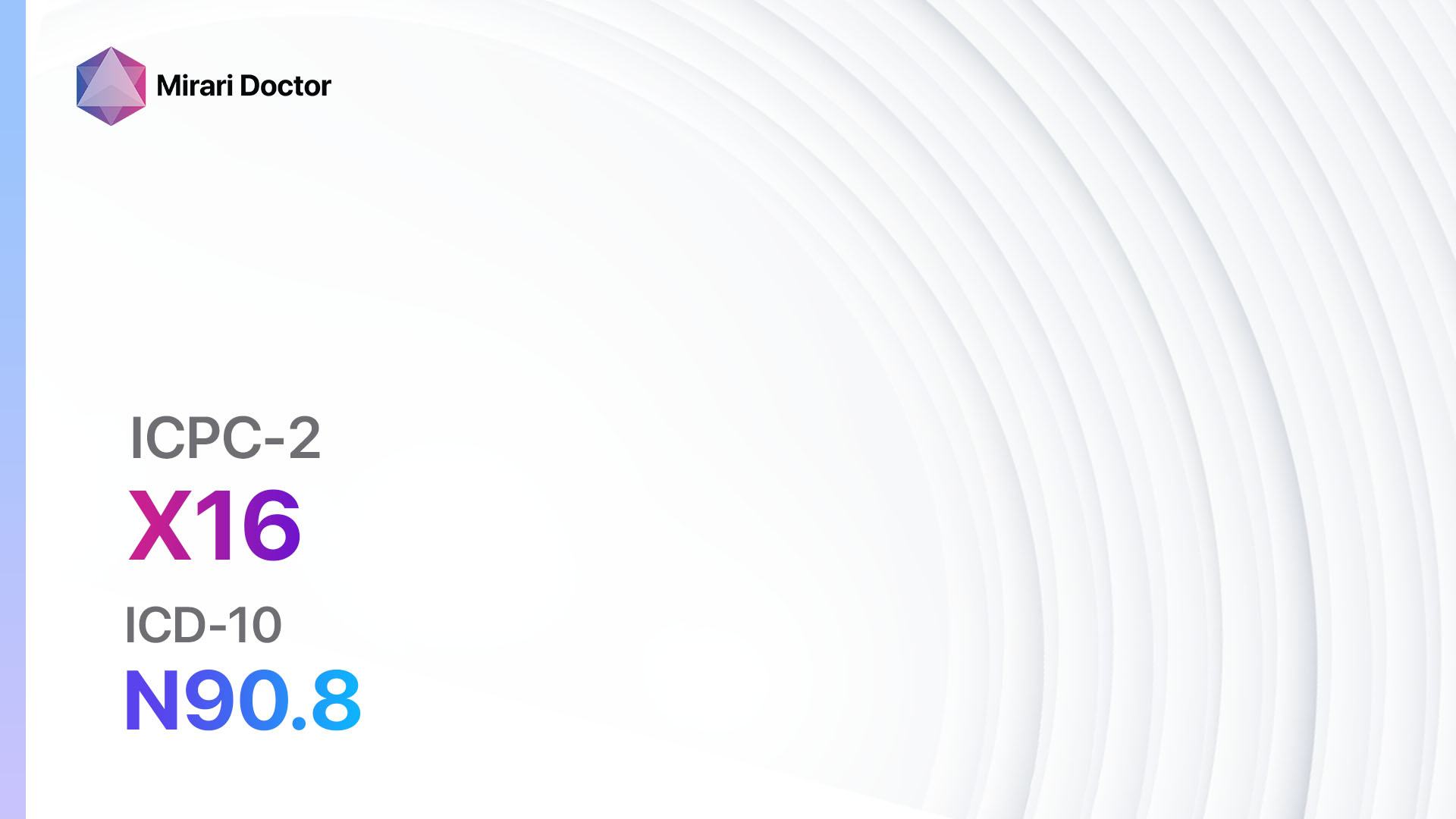
Introduction
Vulval symptoms or complaints refer to any discomfort, pain, or abnormality in the external female genitalia, including the labia, clitoris, and vaginal opening. These symptoms can be indicative of various underlying conditions, such as infections, dermatological disorders, or hormonal imbalances[1]. The aim of this guide is to provide healthcare professionals with a comprehensive approach to diagnosing and managing vulval symptoms.
Codes
- ICPC-2 Code: X16 Vulval symptom/complaint
- ICD-10 Code: N90.8 Other specified noninflammatory disorders of vulva and perineum
Symptoms
- Itching: Persistent itching in the vulval area.
- Pain or discomfort: Pain or discomfort in the vulval area, especially during urination or sexual intercourse.
- Redness or swelling: Visible redness or swelling of the vulval area.
- Abnormal discharge: Unusual vaginal discharge, such as increased amount, change in color or odor.
- Skin changes: Changes in the texture, color, or appearance of the vulval skin.
- Ulcers or sores: Presence of ulcers, sores, or lesions on the vulval area.
- Burning or stinging sensation: A burning or stinging sensation in the vulval area[2].
Causes
- Infections: Vulvovaginal candidiasis (yeast infection), bacterial vaginosis, trichomoniasis, genital herpes, or other sexually transmitted infections.
- Dermatological disorders: Contact dermatitis, lichen sclerosus, lichen planus, or psoriasis.
- Hormonal imbalances: Estrogen deficiency, such as in menopause or after childbirth.
- Allergic reactions: Allergic reactions to soaps, detergents, or other personal care products.
- Vulvar cancer: Rare, but can present with vulval symptoms[3][4].
Diagnostic Steps
Medical History
- Obtain a detailed medical history, including the duration and progression of symptoms, any associated factors (such as sexual activity or product use), and any previous treatments or interventions.
- Inquire about any previous or current medical conditions, such as diabetes or autoimmune disorders, that may contribute to vulval symptoms.
- Assess for any risk factors for sexually transmitted infections, such as multiple sexual partners or unprotected sex[5].
Physical Examination
- Perform a thorough physical examination of the vulval area, including inspection of the external genitalia, labia, clitoris, and vaginal opening.
- Look for any visible signs of redness, swelling, ulcers, or lesions.
- Palpate the vulval area for tenderness or abnormal masses.
- Evaluate the surrounding skin for any signs of dermatological disorders, such as lichen sclerosus or psoriasis[6].
Laboratory Tests
- Collect a vaginal swab for microscopy and culture to identify the presence of any infectious organisms, such as yeast or bacteria.
- Perform a wet mount preparation to assess for the presence of Trichomonas vaginalis.
- Consider testing for sexually transmitted infections, such as herpes simplex virus or human papillomavirus, if indicated based on the patient’s history or examination findings.
- Blood tests may be ordered to evaluate hormonal levels, such as estrogen, if hormonal imbalances are suspected[7].
Diagnostic Imaging
- Diagnostic imaging is not typically required for the evaluation of vulval symptoms. However, in certain cases, imaging modalities such as ultrasound or MRI may be used to assess for deeper tissue involvement or to rule out vulvar cancer[8].
Other Tests
- A biopsy of any suspicious lesions or ulcers may be necessary to confirm a diagnosis of vulvar cancer or to evaluate for other dermatological disorders.
- Allergy testing may be considered if an allergic reaction is suspected as the cause of vulval symptoms[9].
Follow-up and Patient Education
- Schedule a follow-up appointment to review the results of any diagnostic tests and to discuss treatment options.
- Provide patient education regarding proper vulval hygiene, avoiding irritants, and safe sexual practices.
- Discuss the importance of regular self-examinations and seeking medical attention for any new or worsening symptoms[10].
Possible Interventions
Traditional Interventions
Medications:
Top 5 drugs for Vulval symptom/complaint:
- Antifungal creams (e.g., Clotrimazole, Miconazole):
- Cost: Over-the-counter options are available for approximately $5-$15. Prescription-strength creams may cost $20-$50.
- Contraindications: Hypersensitivity to the medication.
- Side effects: Local irritation, burning, or itching.
- Severe side effects: Rare, but may include severe allergic reactions.
- Drug interactions: Minimal drug interactions reported.
- Warning: Follow the recommended treatment duration and avoid sexual activity during treatment.
- Topical corticosteroids (e.g., Hydrocortisone):
- Cost: Over-the-counter options are available for approximately $5-$15. Prescription-strength creams may cost $20-$50.
- Contraindications: Hypersensitivity to the medication, active infection.
- Side effects: Thinning of the skin, skin discoloration, or irritation.
- Severe side effects: Rare, but may include systemic absorption and adrenal suppression with prolonged use.
- Drug interactions: Minimal drug interactions reported.
- Warning: Use as directed and avoid prolonged use without medical supervision.
- Antibiotics (e.g., Metronidazole, Clindamycin):
- Cost: Generic versions can be $10-$30 for a course of treatment.
- Contraindications: Hypersensitivity to the medication, pregnancy (in some cases).
- Side effects: Nausea, metallic taste in the mouth, or diarrhea.
- Severe side effects: Rare, but may include severe allergic reactions or Clostridium difficile infection.
- Drug interactions: Minimal drug interactions reported.
- Warning: Complete the full course of treatment as prescribed.
- Hormonal therapy (e.g., Estrogen creams):
- Cost: Prescription-strength creams may cost $20-$50.
- Contraindications: History of estrogen-dependent cancer, undiagnosed vaginal bleeding.
- Side effects: Local irritation, breast tenderness.
- Severe side effects: Rare, but may include increased risk of blood clots or stroke.
- Drug interactions: Minimal drug interactions reported.
- Warning: Use as directed and discuss any concerns with a healthcare professional.
- Antiviral medications (e.g., Acyclovir, Valacyclovir):
- Cost: Generic versions can be $10-$30 for a course of treatment.
- Contraindications: Hypersensitivity to the medication.
- Side effects: Nausea, headache, or dizziness.
- Severe side effects: Rare, but may include severe allergic reactions or kidney problems.
- Drug interactions: Minimal drug interactions reported.
- Warning: Complete the full course of treatment as prescribed.
Alternative Drugs:
- Antihistamines (e.g., Loratadine, Cetirizine): May help relieve itching associated with allergic reactions. Cost: Over-the-counter options are available for approximately $5-$15.
- Emollients (e.g., Petroleum jelly, Aloe vera gel): Can provide relief from dryness and irritation. Cost: Over-the-counter options are available for approximately $5-$15.
- Immunomodulators (e.g., Tacrolimus, Pimecrolimus): May be used for certain dermatological disorders. Cost: Prescription-strength creams may cost $20-$50.
Surgical Procedures:
- Surgical interventions are not typically required for the management of vulval symptoms. However, in cases of vulvar cancer or severe dermatological disorders, surgical excision or reconstruction may be necessary.
Alternative Interventions
- Cool compresses: Applying cool compresses to the vulval area may help reduce itching and inflammation. Cost: Minimal cost.
- Sitz baths: Soaking the vulval area in warm water with added salt or baking soda can provide relief from itching and discomfort. Cost: Minimal cost.
- Avoiding irritants: Educate the patient on avoiding potential irritants, such as scented soaps, douches, or tight-fitting clothing. Cost: Minimal cost.
- Stress reduction techniques: Stress reduction techniques, such as meditation or yoga, may help alleviate symptoms associated with certain dermatological disorders. Cost: Varies depending on the specific technique.
- Dietary modifications: Encourage a healthy diet rich in fruits, vegetables, and whole grains to support overall vulval health. Cost: Varies depending on individual food choices.
Lifestyle Interventions
- Proper vulval hygiene: Instruct the patient on proper vulval hygiene, including gentle cleansing with mild soap and water, avoiding excessive scrubbing or douching. Cost: Minimal cost.
- Cotton underwear: Recommend wearing breathable cotton underwear to promote airflow and reduce moisture in the vulval area. Cost: Minimal cost.
- Avoiding tight-fitting clothing: Advise the patient to avoid wearing tight-fitting clothing, such as skinny jeans or synthetic fabrics, which can trap moisture and irritate the vulval area. Cost: Minimal cost.
- Sexual practices: Educate the patient on safe sexual practices, including the use of barrier methods, such as condoms, to reduce the risk of sexually transmitted infections. Cost: Minimal cost.
- Stress management: Encourage stress management techniques, such as exercise, relaxation exercises, or counseling, to reduce the impact of stress on vulval symptoms. Cost: Varies depending on the specific technique.
It is important to note that the cost ranges provided are approximate and may vary depending on the location and availability of the interventions.
Mirari Cold Plasma Alternative Intervention
Understanding Mirari Cold Plasma
- Safe and Non-Invasive Treatment: Mirari Cold Plasma is a safe and non-invasive treatment option for various skin conditions. It does not require incisions, minimizing the risk of scarring, bleeding, or tissue damage.
- Efficient Extraction of Foreign Bodies: Mirari Cold Plasma facilitates the removal of foreign bodies from the skin by degrading and dissociating organic matter, allowing easier access and extraction.
- Pain Reduction and Comfort: Mirari Cold Plasma has a local analgesic effect, providing pain relief during the treatment, making it more comfortable for the patient.
- Reduced Risk of Infection: Mirari Cold Plasma has antimicrobial properties, effectively killing bacteria and reducing the risk of infection.
- Accelerated Healing and Minimal Scarring: Mirari Cold Plasma stimulates wound healing and tissue regeneration, reducing healing time and minimizing the formation of scars.
Mirari Cold Plasma Prescription
Video instructions for using Mirari Cold Plasma Device – X16 Vulval symptom/complaint (ICD-10:N90.8)
| Mild | Moderate | Severe |
| Mode setting: 1 (Infection) Location: 0 (Localized) Morning: 15 minutes, Evening: 15 minutes |
Mode setting: 1 (Infection) Location: 0 (Localized) Morning: 30 minutes, Lunch: 30 minutes, Evening: 30 minutes |
Mode setting: 1 (Infection) Location: 0 (Localized) Morning: 30 minutes, Lunch: 30 minutes, Evening: 30 minutes |
| Mode setting: 2 (Wound Healing) Location: 0 (Localized) Morning: 15 minutes, Evening: 15 minutes |
Mode setting: 2 (Wound Healing) Location: 0 (Localized) Morning: 30 minutes, Lunch: 30 minutes, Evening: 30 minutes |
Mode setting: 2 (Wound Healing) Location: 0 (Localized) Morning: 30 minutes, Lunch: 30 minutes, Evening: 30 minutes |
| Mode setting: 3 (Antiviral Therapy) Location: 2 (Prostate & Uterus) Morning: 15 minutes, Evening: 15 minutes |
Mode setting: 3 (Antiviral Therapy) Location: 2 (Prostate & Uterus) Morning: 30 minutes, Lunch: 30 minutes, Evening: 30 minutes |
Mode setting: 3 (Antiviral Therapy) Location: 2 (Prostate & Uterus) Morning: 30 minutes, Lunch: 30 minutes, Evening: 30 minutes |
| Mode setting: 7 (Immunotherapy) Location: 1 (Sacrum) Morning: 15 minutes, Evening: 15 minutes |
Mode setting: 7 (Immunotherapy) Location: 1 (Sacrum) Morning: 30 minutes, Lunch: 30 minutes, Evening: 30 minutes |
Mode setting: 7 (Immunotherapy) Location: 1 (Sacrum) Morning: 30 minutes, Lunch: 30 minutes, Evening: 30 minutes |
| Total Morning: 60 minutes approx. $10 USD, Evening: 60 minutes approx. $10 USD |
Total Morning: 120 minutes approx. $20 USD, Lunch: 120 minutes approx. $20 USD, Evening: 120 minutes approx. $20 USD, |
Total Morning: 120 minutes approx. $20 USD, Lunch: 120 minutes approx. $20 USD, Evening: 120 minutes approx. $20 USD, |
| Usual treatment for 7-60 days approx. $140 USD – $1200 USD | Usual treatment for 6-8 weeks approx. $2,520 USD – $3,360 USD |
Usual treatment for 3-6 months approx. $5,400 USD – $10,800 USD
|
 |
|
Use the Mirari Cold Plasma device to treat Vulval symptom/complaint effectively.
WARNING: MIRARI COLD PLASMA IS DESIGNED FOR THE HUMAN BODY WITHOUT ANY ARTIFICIAL OR THIRD PARTY PRODUCTS. USE OF OTHER PRODUCTS IN COMBINATION WITH MIRARI COLD PLASMA MAY CAUSE UNPREDICTABLE EFFECTS, HARM OR INJURY. PLEASE CONSULT A MEDICAL PROFESSIONAL BEFORE COMBINING ANY OTHER PRODUCTS WITH USE OF MIRARI.
Step 1: Cleanse the Skin
- Start by cleaning the affected area of the skin with a gentle cleanser or mild soap and water. Gently pat the area dry with a clean towel.
Step 2: Prepare the Mirari Cold Plasma device
- Ensure that the Mirari Cold Plasma device is fully charged or has fresh batteries as per the manufacturer’s instructions. Make sure the device is clean and in good working condition.
- Switch on the Mirari device using the power button or by following the specific instructions provided with the device.
- Some Mirari devices may have adjustable settings for intensity or treatment duration. Follow the manufacturer’s instructions to select the appropriate settings based on your needs and the recommended guidelines.
Step 3: Apply the Device
- Place the Mirari device in direct contact with the affected area of the skin. Gently glide or hold the device over the skin surface, ensuring even coverage of the area experiencing.
- Slowly move the Mirari device in a circular motion or follow a specific pattern as indicated in the user manual. This helps ensure thorough treatment coverage.
Step 4: Monitor and Assess:
- Keep track of your progress and evaluate the effectiveness of the Mirari device in managing your Vulval symptom/complaint. If you have any concerns or notice any adverse reactions, consult with your health care professional.
Note
This guide is for informational purposes only and should not replace the advice of a medical professional. Always consult with your healthcare provider or a qualified medical professional for personal advice, diagnosis, or treatment. Do not solely rely on the information presented here for decisions about your health. Use of this information is at your own risk. The authors of this guide, nor any associated entities or platforms, are not responsible for any potential adverse effects or outcomes based on the content.
Mirari Cold Plasma System Disclaimer
- Purpose: The Mirari Cold Plasma System is a Class 2 medical device designed for use by trained healthcare professionals. It is registered for use in Thailand and Vietnam. It is not intended for use outside of these locations.
- Informational Use: The content and information provided with the device are for educational and informational purposes only. They are not a substitute for professional medical advice or care.
- Variable Outcomes: While the device is approved for specific uses, individual outcomes can differ. We do not assert or guarantee specific medical outcomes.
- Consultation: Prior to utilizing the device or making decisions based on its content, it is essential to consult with a Certified Mirari Tele-Therapist and your medical healthcare provider regarding specific protocols.
- Liability: By using this device, users are acknowledging and accepting all potential risks. Neither the manufacturer nor the distributor will be held accountable for any adverse reactions, injuries, or damages stemming from its use.
- Geographical Availability: This device has received approval for designated purposes by the Thai and Vietnam FDA. As of now, outside of Thailand and Vietnam, the Mirari Cold Plasma System is not available for purchase or use.
References
- ACOG Committee Opinion No. 734: The Role of Transvaginal Ultrasonography in Evaluating the Endometrium of Women With Postmenopausal Bleeding. Obstetrics & Gynecology. 2018;131(5):e124-e129.
- Paavonen J. Vulvodynia—a complex syndrome of vulvar pain. Acta Obstetricia et Gynecologica Scandinavica. 1995;74(4):243-247.
- Mitra S, Sharma MK, Kaur I, et al. Vulvar and vaginal disorders: Diagnosis and management. Journal of Mid-life Health. 2015;6(4):160-175.
- Lawton S. Vulval skin conditions: disease activity and quality of life. British Journal of Dermatology. 2019;180(2):226-227.
- Edwards L. Vulvar symptoms: A self-management guide. Journal of Lower Genital Tract Disease. 2003;7(1):51-57.
- Stockdale CK, Boardman L. Diagnosis and Treatment of Vulvar Dermatoses. Obstetrics and Gynecology. 2018;131(2):371-386.
- Sobel JD. Vulvovaginal candidosis. The Lancet. 2007;369(9577):1961-1971.
- Bornstein J, Goldstein AT, Stockdale CK, et al. 2015 ISSVD, ISSWSH, and IPPS Consensus Terminology and Classification of Persistent Vulvar Pain and Vulvodynia. Journal of Sexual Medicine. 2016;13(4):607-612.
- Moyal-Barracco M, Lynch PJ. 2003 ISSVD terminology and classification of vulvodynia: a historical perspective. Journal of Reproductive Medicine. 2004;49(10):772-777.
- Haefner HK, Collins ME, Davis GD, et al. The Vulvodynia Guideline. Journal of Lower Genital Tract Disease. 2005;9(1):40-51.
Related articles
Made in USA














